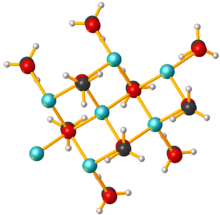 | |
| Names | |
|---|---|
| IUPAC name Sodium methoxide | |
| Other names Sodium methylate | |
| Identifiers | |
3D model (JSmol) | |
| ChemSpider | |
| ECHA InfoCard | 100.004.273 |
PubChem CID | |
| UNII | |
CompTox Dashboard (EPA) | |
| |
| |
| Properties | |
| CH3NaO | |
| Molar mass | 54.02 g/mol |
| Appearance | White solid |
| Melting point | 127 °C (261 °F; 400 K) |
| Boiling point | 350 °C (662 °F; 623 K) [1] (decomposition) |
| Reacts with water | |
| Solubility | Soluble in ethanol, methanol Insoluble in hydrocarbons |
| Structure | |
| Hexagonal | |
| Hazards | |
| GHS labelling: | |
   | |
| Danger | |
| H251, H302, H314 [2] | |
| P235+P410, P280, P305+P351+P338, P310 [2] | |
| Safety data sheet (SDS) | Sigma [2] |
Except where otherwise noted, data are given for materials in their standard state (at 25 °C [77 °F], 100 kPa). | |
Sodium methoxide is the simplest sodium alkoxide. With the formula CH3ONa, it is a white solid, which is formed by the deprotonation of methanol. It is a widely used reagent in industry and the laboratory. It is also a dangerously caustic base.

